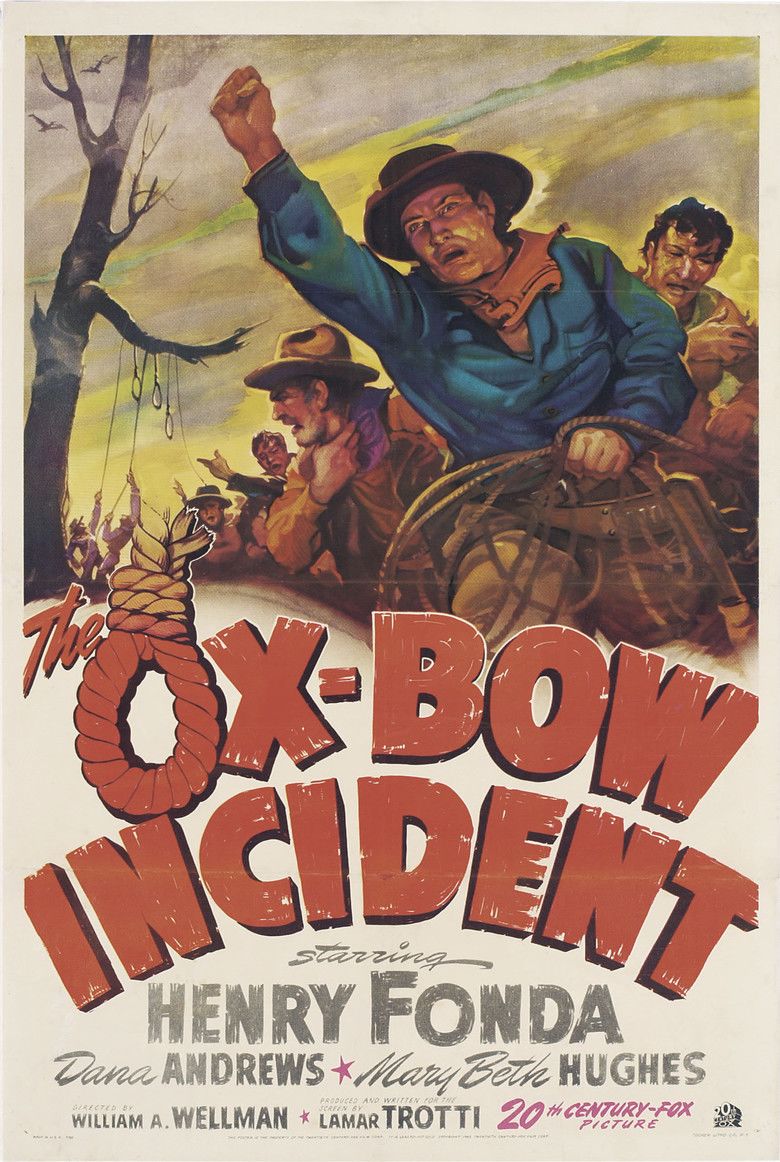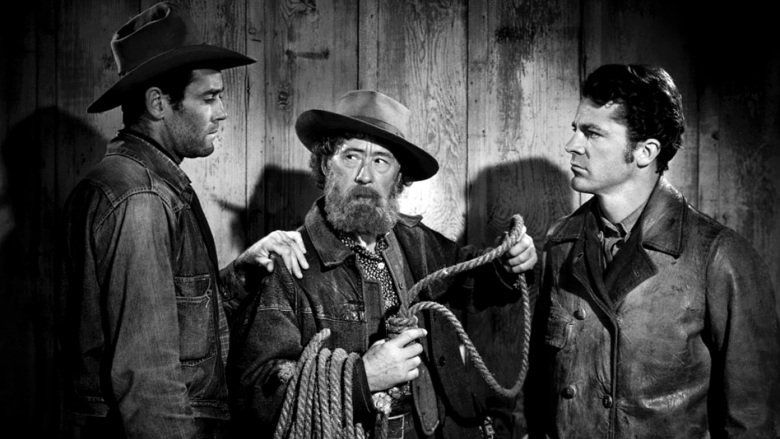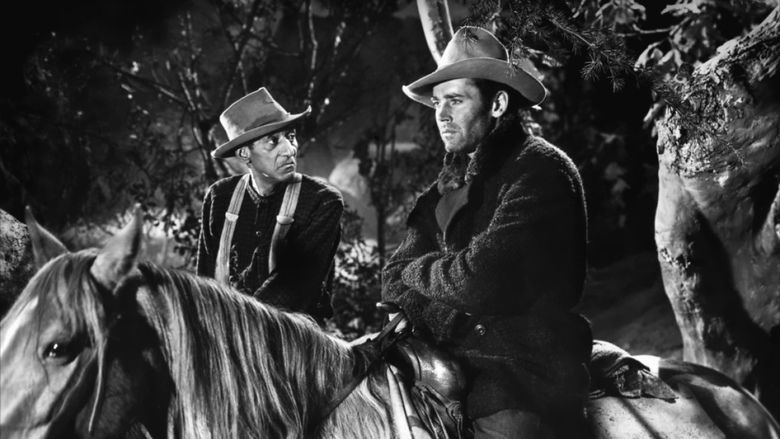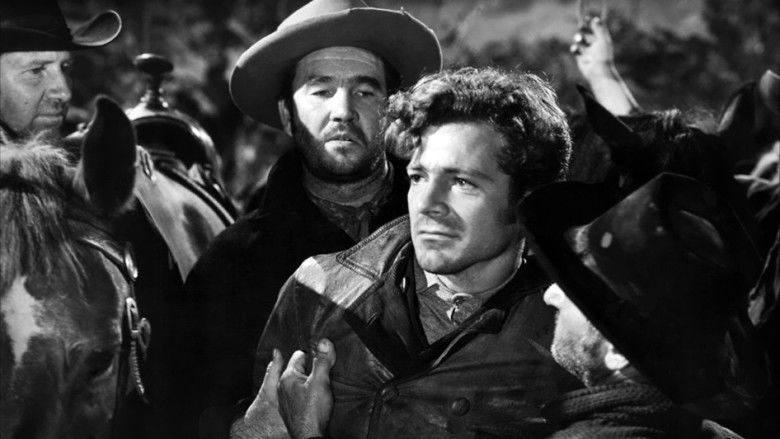The Ox Bow Incident
8.8 /10 1 Votes
94% Rotten Tomatoes | 8.1/10 IMDb Initial DVD release November 4, 2003 Duration Language English | |||||||||||||||||||||||||||||||||
 | ||||||||||||||||||||||||||||||||||
Release date May 21, 1943 (1943-05-21) Cast (Gil Carter), (Donald Martin), (Rose Mapen/Rose Swanson), (Juan Martínez/Francisco Morez), (Jenny Grier), Matt Briggs (Judge Daniel Tyler)Similar movies The Return of Wild Bill Tagline Tough! True! Terrifying! | ||||||||||||||||||||||||||||||||||
Consci ncias mortas 1943 the ox bow incident avec
The Ox-Bow Incident is a 1943 American Western film noir directed by William A. Wellman, starring Henry Fonda, Dana Andrews and Mary Beth Hughes, with Anthony Quinn, William Eythe, Harry Morgan and Jane Darwell. Two drifters are passing through a Western town, when news arrives that a local rancher has been murdered and his cattle stolen. The townspeople, joined by the drifters, form a posse to catch the perpetrators. They find three men in possession of the cattle, and are determined to see justice done on the spot.
Contents
- Consci ncias mortas 1943 the ox bow incident avec
- Henry fonda the ox bow incident conscience monologue
- Plot
- Production
- Reception
- Awards and honors
- References

The film premiered in May 1943 to positive reviews from critics. It was nominated for the Academy Award for Best Picture at the 16th Academy Awards, losing to Casablanca.

In 1998, the film was selected for preservation in the United States National Film Registry by the Library of Congress as being "culturally, historically, or aesthetically significant". The film was adapted from the 1940 novel of the same name, written by Walter Van Tilburg Clark.

Henry fonda the ox bow incident conscience monologue
Plot

In Bridger's Wells, Nevada in 1885, Art Croft (Harry Morgan) and Gil Carter (Henry Fonda) ride into town and enter Darby's Saloon. The atmosphere is subdued due to recent incidents of cattle-rustling. Art and Gil are suspected to be rustlers because they have rarely been seen in town.

A man enters the saloon and announces that a rancher named Larry Kinkaid has been murdered. The townspeople immediately form a posse to pursue the murderers, whom they believe are cattle rustlers. A judge tells the posse that it must bring the suspects back for trial, and that its formation by a deputy (the sheriff being out of town) is illegal. Art and Gil join the posse to avoid raising even more suspicion. Davies (Harry Davenport), who was initially opposed to forming the posse, also joins, along with "Major" Tetley (Frank Conroy) and his son Gerald (William Eythe). Poncho informs the posse that three men and cattle bearing Kinkaid's brand have just entered Bridger's Pass.

The posse encounters a stagecoach. When they try to stop it, the stagecoach guard assumes that it is a stickup, and shoots, wounding Art. In the coach are Rose Mapen (Mary Beth Hughes), Gil's ex-girlfriend, and her new husband, Swanson (George Meeker).
Later that night in Ox-Bow Canyon, the posse finds three men sleeping, with what are presumed to be stolen cattle nearby. The posse interrogates them: a young, well-spoken man, Donald Martin (Dana Andrews); a Mexican, Juan Martínez (Anthony Quinn); and an old man, Alva Hardwicke (Francis Ford, brother of film director John Ford). Martin claims that he purchased the cattle from Kinkaid but received no bill of sale. No one believes Martin, and the posse decides to hang the three men at sunrise.
Martin writes a letter to his wife and asks Davies, the only member of the posse that he trusts, to deliver it. Davies reads the letter, and, hoping to save Martin's life, shows it to the others. Davies believes that Martin is innocent and does not deserve to die.
The Mexican "Juan" is recognized as a gambler named Francisco Morez. He tries to escape and is shot and wounded. The posse discovers that Morez has Kinkaid's gun.
Major Tetley wants the men to be lynched immediately. A vote is taken as to whether the men should be hanged or taken back to stand trial. Only seven, among them Davies, Gerald Tetley, Gil and Art, vote to take the men back to town alive; the rest support immediate hanging. Gil tries to stop it, but is overpowered.
After the lynching, the posse heads back towards Bridger's Wells and encounters Sheriff Risley, who tells them that Lawrence Kinkaid is not dead and that the men who shot him have been arrested. Risley strips the deputy of his badge.
The men of the posse gather in Darby's Saloon and drink in silence. Major Tetley returns to his house and shoots himself after his son condemns him for being sadistic. In the saloon, Gil reads Martin's letter while members of the posse listen. In the final scene Gil and Art head out of town to deliver the letter and $500 raised by those in the posse to Martin's wife.
Production
Director William A. Wellman loved the novel and wanted to adapt it into a film and then interested Darryl F. Zanuck in producing it. Zanuck agreed in producing the story, on the condition that Wellman would also direct two other films for the studio, Thunder Birds and Buffalo Bill (1944).
The role of Gil Carter, played by Henry Fonda, was originally offered to Gary Cooper, who turned it down. Fonda was generally unhappy with the quality of the films he was cast in while under contract with 20th Century Fox. This was one of only two films from that period that he was enthusiastic about acting in (the other was The Grapes of Wrath, made in 1940). Fonda regarded this film as one of his favorites.
Filming was done from late June to early August 1942, mostly in studio back-lots and sound stages; a limited amount of location shooting was done at a ranch in Chatsworth and in Lone Pine, both in California. Additional sequences and retakes were done mid-August to late August. The production on the film would be shut down for a week or ten days "due to the $5,000-per-film limit on new construction materials" (imposed by the War Production Board). During the shutdown, already used sets were torn down so their materials could be used to build the mountain pass set. Studio publicity noted that the Ox-Bow Valley setting was "the largest set ever constructed" by Fox, covering 26,703 square feet.
The western street set seen in this film was subsequently used in another western, The Gunfighter (1950), which starred Gregory Peck.
After filming was completed, Fonda immediately enlisted in the U.S. Navy, in which he served until 1946.
After the film was completed, it was kept on the shelf for months because Fox executives were uncertain how to market a film with such a sobering theme.
Reception
The film received mostly positive reviews. Bosley Crowther of The New York Times wrote that it "is not a picture which will brighten or cheer your day. But it is one which, for sheer, stark drama, is currently hard to beat." Variety called it a "powerful preachment against mob lynching ... Director William Wellman has skillfully guided the characters and driven home the point that hanging is unwarranted. Fonda measures up to star rating ... He helps hold together the loose ends of the rather patent plot." David Lardner of The New Yorker called it a "rather good piece of work". Harrison's Reports printed a negative review, calling it a "depressing, unpleasant, at times horrible, melodrama ... Whoever is responsible for selecting such sordid material for the screen should be awarded a 'booby' prize."
More recently, La Furia Umana's Toshi Fujiwara said the film is "one of the most important westerns in the history of American cinema". Clint Eastwood has stated this is his favorite film. However, Darryl F. Zanuck, head of Twentieth Century-Fox 1935-1956, recalled the film as 'a flop. In spite of its significance and its dramatic value, our records showed that it had failed to pay its way. In fact, its pulling power was less than that of a Laurel and Hardy comedy we made about the same time.'
It earned $750,000 in the United States.
Awards and honors
The film was nominated for the Academy Award for Best Picture at the 16th Academy Awards, losing to Casablanca. As of 2017, it is the last film to be nominated for Best Picture and nothing else.
References
The Ox-Bow Incident WikipediaThe Ox-Bow Incident IMDbThe Ox-Bow Incident Rotten TomatoesThe Ox Bow Incident themoviedb.org
